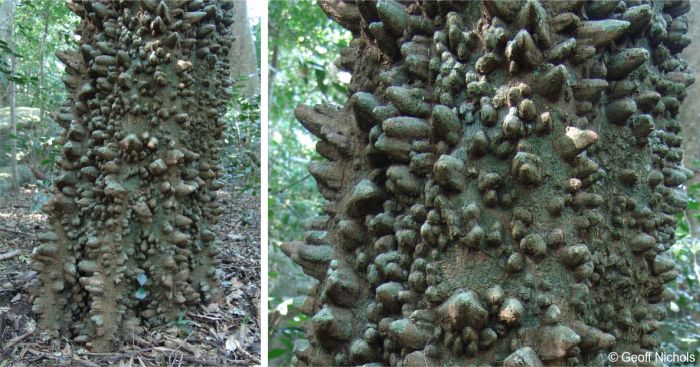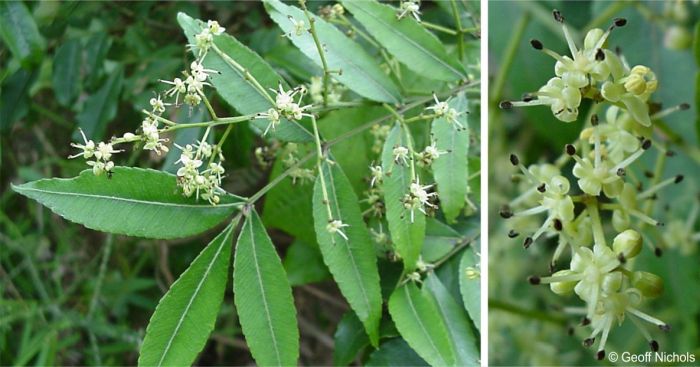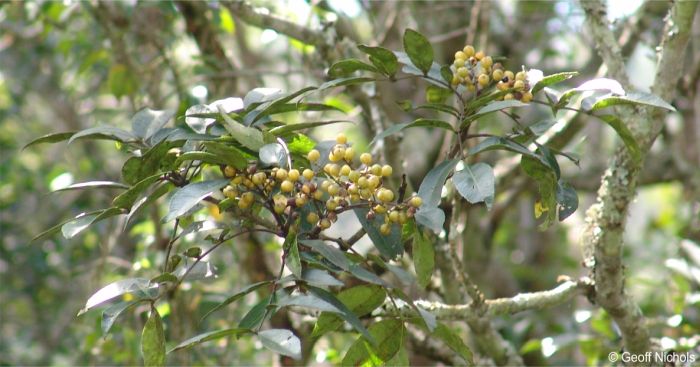Zanthoxylum davyi
Zanthoxylum davyi (I.Verd.) P.G.Waterman
Family: Rutaceae
Common names: forest knobwood, forest knobthorn (Eng.); bosperdepram, knopdoringhout (Afr.); umnugumabele, umnungwane, umnungwane omkhulu (isiZulu); tshamavhudzi, munungu, murandela (Tshivenda); umnungumabele, umlungumabele (isiXhosa); monokwane, senokomaropa, senoko-maropa, senokumarupa (Sepedi)
SA Tree No: 254
Introduction
The forest knobwood tree, scientifically known as Zanthoxylum davyi, is a remarkable presence in southern African forests, with its its impressive height, distinctive wrinkled grey-brown bark adorned with horn-like knobs, glossy green lemon-scented leaves and clusters of creamy-white flowers in spring. Beyond its unique appearance and visual appeal, it holds cultural and ecological importance, providing inspiration and sustenance for indigenous communities and wildlife. This tree is a favourite among gardeners as it attracts numerous birds, adding to the charm of any garden space.

Description
Description
Zanthoxylum davyi, is a prickly, dioecious tree, well known for its tall stature, reaching heights of up to 30 m. Its stand-out feature is its bark, which appears wrinkled and has a grey-brown colour, and the trunk is studded with horn-like, spine-tipped knobs. The branches are armed with slightly upward-curving spines. The leaves are large, shiny and green, spiralled at branchlet ends, adding to its overall appeal. They are compound leaves, with approximately 20-70 mm long and 8-30 mm wide leaflets borne in 3-6 pairs with a terminal leaflet, to form a complete leaf of 80-300 mm long. Leaves are also characterised by a yellow midrib, finely scalloped margins and gland dots on the leaf blade. The leaves are lemon-scented when crushed.
During the spring season, typically from September to December, forest knobwood blossoms with small creamy-white flowers in short terminal sprays, attracting various pollinators. The flowering period usually lasts for several weeks, contributing to the tree's ornamental value. Male and female flowers are borne on separate trees (dioecious). As the season progresses into summer, usually from December to February, these flowers give way to small, spherical, glossy fruits, green ripening to a dark reddish-brown and persisting on the tree for an extended period, attracting birds throughout the fruiting season. These fruits are also gland-dotted and are known for emitting a lemon scent. The fruit splits to release a hard, shiny, black seed.

Conservation Status
Status
Zanthoxylum davyi is classified as Least Concern (LC) according to the SANBI Red List of South African Plants.
Distribution and habitat
Distribution description
Zanthoxylum davyi is indigenous to the southern regions of Africa, where it thrives in the Forest Biome. While forest knobwood is primarily found in South Africa, were it grows in forest and forest patches from Knysna in the Western Cape northwards throught the Eastern Cape, KwaZulu-Natal, Mpumalanga and Limpopo provinces, it is also present in eastern Zimbabwe and Eswatini, in similar climatic conditions and habitats. Its distribution may vary within these regions, influenced by factors such as altitude, temperature, and precipitation. Overall, forest knobwood's ability to adapt to different environmental conditions underscores its significance within the biodiversity of the areas it inhabits its resilience and versatility.
In its preferred habitat, forest knobwood thrives in areas with ample sunlight and well-drained soil. It can tolerate both sandy and clay soils, making it adaptable to various terrain types. It contributes to the local ecosystem by providing food and shelter for wildlife.
Derivation of name and historical aspects
History
The scientific name of forest knobwood, Zanthoxylum davyi, carries a rich history and botanical significance. The genus name, Zanthoxylum, originates from the Greek words zanthos, meaning ‘yellow’, and xylon, meaning ‘wood’, alluding to the yellowish colour of the wood in some species in this genus. This name highlights the distinctive characteristics of the genus, which includes various species of trees and shrubs known for their aromatic properties and spiny branches and trucks. The specific epithet, davyi, pays homage to the botanist Joseph Burtt Davy (1870-1940), who was the founder of the Transvaal Government Herbarium, now the National Herbarium, situated in the Pretoria National Botanical Garden.
Historically, forest knobwood has been recognized for its cultural and ecological significance in the regions where it occurs. Indigenous communities have long utilized various parts of the tree for medicinal purposes, as well as for crafting tools and implements.
Within the botanical classification system, forest knobwood belongs to the Rutaceae family, commonly known as the citrus family. This family encompasses a diverse plant group, including trees, shrubs, and herbs, distributed across different regions worldwide. The Rutaceae family is characterized by its aromatic foliage and often contains species with economic and medicinal importance. The genus Zanthoxylum, to which Knobwood belongs, is a prominent member of the Rutaceae family, known for its spiny branches and pungent fruits.
Ecology
Ecology
Forest knobwood, or Zanthoxylum davyi, plays a vital role in its ecological community, contributing to the biodiversity and functioning of its habitat. Trees undergo seasonal changes, shedding leaves and regenerating them when conditions are favourable. This cycle influences nutrient cycling and soil composition, as fallen leaves decompose and enrich the soil with organic matter.
Forest knobwood's flowers, which bloom in spring, attract pollinators such as bees and butterflies, facilitating the reproduction of other plant species in the area. Furthermore, the tree's fruits provide a valuable food source for birds and small mammals, which aid in seed dispersal and promote the regeneration of the forest. Forest knobwood's presence also contributes to the microclimate of its habitat, providing shade and shelter for understory plants and creating a favourable environment for a diverse array of flora and fauna.

Uses
Use
Zanthoxylum davyi, holds significant cultural value particularly within the different tribes in South Africa. Indigenous communities have long revered this tree for its multifaceted uses, incorporating various parts of it into their daily lives. The durable wood of forest knobwood has been traditionally employed in crafting tools, implements, walking sticks and household items due to its strength and resilience. Additionally, the aromatic properties of the wood have made it popular for smoking and seasoning meats, enhancing their flavour and preserving them for longer periods. The knobs on the trunk are part of the bark and are relatively easily broken off and have been used to make pipes, and children’s toys.
Beyond its practical applications, forest knobwood holds a prominent place in local folklore and spiritual practices. It is often regarded as a sacred tree, associated with rituals and ceremonies that celebrate the interconnectedness of nature and humanity. The tree's fragrant fruits and flowers have symbolic significance in cultural traditions, serving as offerings in religious ceremonies or as decorative elements in festive celebrations. Moreover, forest knobwood’s presence in the landscape is believed to bring blessings and protection to communities, fostering a sense of connection to the natural world.
Forest knobwood also plays a role in traditional medicine practices. Various parts of the tree, including the bark, leaves, roots and fruits, are believed to possess medicinal properties and have been used to treat a range of ailments, including fever, colds and flu, digestive disorders, skin conditions, toothache and as a mouthwash. Indigenous healers often prepare herbal remedies and infusions from forest knobwood, drawing upon centuries-old knowledge passed down through generations. While scientific research on the medicinal properties of forest knobwood is ongoing, its importance in traditional medicine underscores its value as a source of natural healing and wellness in local communities.
One of the tree's notable characteristics is its ability to attract a variety of birds, making it a popular choice for gardeners looking to create a vibrant and lively outdoor space. Forest knobwood's unique appearance, coupled with its aromatic foliage, fruits and blooms, extended fruiting period, and ability to attract wildlife, adds a special charm to any landscape it graces.

Growing Zanthoxylum davyi
Grow
Forest knobwood is typically propagated through seeds, which can be collected from mature fruits and planted in well-drained soil with adequate sunlight. Prior to planting, it is recommended to scarify the seeds by gently abrading the seed coat, to improve germination rates. Forest knobwood seeds should be sown at a depth of about 1 to 2 cm in the soil and kept moist until germination occurs, which usually takes several weeks to months.
Once established, forest knobwood thrives in a variety of soil types, including sandy and clay soils, as long as they are well-drained. The tree prefers full sunlight but can tolerate partial shade, making it adaptable to different growing conditions. Regular watering is essential, especially during the establishment phase, to encourage root development and ensure healthy growth. Pruning may be necessary to maintain the desired shape and size of the tree, as well as to remove any dead or diseased branches.
In terms of cultivation, forest knobwood can be grown as a focal specimen tree in gardens, and urban landscapes, where its ornamental features and aromatic foliage and fruits can be appreciated.
References
- Boon, R. 2010. Pooley's trees of eastern South Africa, a complete guide. Flora & Fauna Publications Trust, Durban.
- Codd, L.E.W., Dyer, R.A., Rycroft, H.B. & Winter, B.D. 1963. Flora of Southern Africa: the Republic of South Africa, Basutoland, Swaziland and South West Africa. Government Printer. Pretoria.
- Launert, E., Bell, E.A., Mendes, E.J. 1985. Flora Zambesiaca: Mozambique, Malawi, Zambia, Zimbabwe, Botswana. Volume 7: Part 2. Royal Botanic Gardens. London.
- Palmer, E. & Pitman, N. 1972. Trees of southern Africa. Balkema, Cape Town.
- Raimondo, D., Von Staden, L., Foden, W., Victor, J.E., Helme, N.A., Turner, R.C., Kamundi, D.A. & Manyama, P.A. (eds) 2009. Red list of South African plants. Strelitzia 25. South African National Biodiversity Institute, Pretoria.
- Van Wyk, B. & Van Wyk, P. 2013. Field guide to trees of southern Africa. Struik Publishers, Cape Town, Johannesburg.
- Victor, J.E. & Bester, S.P. 2019. Rutaceae. In C.L. Bredenkamp (ed.), A Flora of the Eastern Cape Province. Strelitzia 41(2): 1429-1444. South African National Biodiversity Institute, Pretoria.
- Watt, J.M. & Breyer-Brandwijk, M.G. 1962. The medicinal and poisonous plants of southern and eastern Africa , edn 2. Livingstone, Edinburgh & London.
Credits
Mpho Mathalauga
Pretoria National Botanical Garden
May 2024
Acknowledgements: images by Geoff Nichols.
Plant Attributes:
Plant Type: Tree
SA Distribution: Eastern Cape, KwaZulu-Natal, Limpopo, Mpumalanga
Soil type: Loam
Flowering season: Spring
PH:
Flower colour: Cream
Aspect: Full Sun, Morning Sun (Semi Shade), Afternoon Sun (Semi Shade)
Gardening skill: Average
Special Features:
Horticultural zones








Rate this article
Article well written and informative
Rate this plant
Is this an interesting plant?
Login to add your Comment
Back to topNot registered yet? Click here to register.